(Robert) George Peters
Family
(Robert) George Peters was born on 1st September 1890 and baptised at St Saviours on 8th February 1891. He was the seventh child of William Henry Peters and his wife Sarah Andrews.
William Henry Peters had first come to Dartmouth when serving in HMS Britannia and had met and married Sarah Andrews there. Subsequently he had transferred to the Coastguard Service, returning to Dartmouth on his retirement. George (as he was subsequently known) was born shortly afterward. For more on his family background, see the story of Percy Cyril Peters, George's younger brother, published last year.
By the time of the 1911 Census, George worked as a coal-lumper in Dartmouth. He lived with his eldest brother William John, and his family, in Lower St. The life of a coal-lumper was hard, and perhaps this encouraged George to volunteer for service when war broke out.
Service
George Peters was one of the first in Dartmouth to join up. On 11th September 1914 the Dartmouth Chronicle carried a column entitled "The Call to Arms", explaining that "it has been proposed to form a "Roll of Honour" consisting of those patriots who have responded to the National Call to Arms during the present great European war". The column consisted of the names of those "who have enlisted during the past fortnight". George's name was twelfth on the list. The newspaper described the unit he was joining as "Lord Kitchener's Army" - in fact, he joined the 1st Battalion Devonshire Regiment, a regular army Battalion.
The 1st Battalion had been mobilised at the outbreak of war and went to France on 21st August 1914. To begin with, it formed part of the rearward contingent of troops defending lines of communication for the British Expeditionary Force, but on 14th September it moved into the front line and fought in the Battle of the Aisne. The 1st Battalion then remained in France for the rest of the war.
The new recruits for the Devons were posted first to the 3rd Battalion - the training and reserve battalion - and at the end of September 1914 it was well over 3000 strong. New companies were formed all over the county, wherever accommodation could be found. From January to April 1915, the 3rd Battalion sent 675 other ranks overseas to the two serving battalions of the Devonshire Regiment (and to other units also). One of these new soldiers was George. The 1914/1915 Star Roll for the Devonshire Regiment records that he went to France on 26th January 1915, and joined the 1st Battalion in the trenches between Ypres and Armentières, near Kemmel.
In April and May 1915 the 1st Battalion were involved in the fierce battle for Hill 60, a German artillery post overlooking the British positions south-east of Ypres, sustaining heavy casualties, but this was followed by nearly three months of relative quiet. The arrival of Kitchener's New Army Divisions in France enabled the British to relieve the French on the Somme, and the 1st Battalion transferred there on 31st July 1915, making them amongst the earliest British troops to arrive in the sector.
Over the next few months they moved in and out of the line, moving from one sector to another, and getting to know the trenches and the surrounding country. Casualties on the Somme - at this time - were light - the Regimental History quotes, by way of example: August -13; September - 16; October - 8; and over the whole period from the beginning of August to the end of the year, 80.
On January 5th 1916, they came out of the line for an extended rest period (for the whole of the 5th Division, of which they were a part), including training and the inevitable working parties, mostly on the roads. During this period, George was evidently allowed leave to return to England to marry. His wife was Kate Crang, born in 1893, daughter of Robert Coyde Crang and Emma Woodman. She came from Churston Ferrers, near Brixham. Before their marriage she had worked as a Cook, in Paignton. She and George can have had only a few weeks of married life at most.
After nearly two months rest, the Battalion was once again moved, this time northward to the sector between Arras and Lens - enabling French forces holding that part of the front to be sent to Verdun, where the Germans had begun their offensive with huge force. Like the Somme, however, this sector of the line was quiet, and remained so - according to the Regimental History:
there were occasional bombardments with much mining and counter-mining, but little infantry activity, and the battalion's casualties were under 50, 15 men being killed and 34 wounded.
At the end of June 1916, the 1st Battalion moved (with the rest of the 5th Division) to the Wailly sector, southwest of Arras. On 30th June, they took over the front line preparatory to launching a local attack, but even as they did so, the plan was dropped. On 2nd July, they left the line, to move back to the Somme.
Battle of the Somme
They arrived on the Somme front on 20th July in reserve in the old German lines at Montauban, in the southern sector of the line, taken on the first day, and now a reserve position as the attack advanced. But, although they were not immediately involved in any British offensive, the "quiet" of the previous year was well and truly over. German artillery knew exactly where the lines were, and the 1st Battalion were immediately subjected to "intermittent shelling with long range guns"; then "heavy shelling with gas shells".
On 23rd July, they moved forward into the front line, and the shelling continued. On the day of the relief they lost five officers wounded, seven men killed, and 44 wounded. On 24th July, they were shelled, and suffered an attempted German attack, which failed, though at a cost of three men killed, and four officers and 35 men wounded. On 25th July they were relieved from the front line, going back to the support trenches, where they remained during the following day, losing six men killed, and two officers and 25 men wounded.
On 27th July, to support an attack on the village of Longueval, two companies were moved forward to hold an old German trench position. They were not required to attack, but nonetheless casualties were "rather heavy" - the War Diary reports seven men killed, and two officers and 74 men wounded, that day, and the following day, one man killed and five wounded. Fortunately, before this attrition rate became unsustainable, they were withdrawn overnight on 29th/30th July and then, with the rest of the Division, moved by stages to a rest area at St Maulvis, well to the west of Amiens. They remained there for three weeks, until 24th August. Some reinforcements arrived, but even so the Battalion was well below strength.
There was some light training, and one route march. But mostly these weeks involved rest and recovery - on 16th August, for example, "a performance was given by the popular divisional concert party, the "Whizz Bangs", on the village square.

Falfemont Farm and Leuze Wood
Returning to the front by train, they were back in the trenches south-west of Guillemont on 26th August, digging an assembly trench and preparing depots for ammunition and other supplies. An attack was in preparation, with the aim of overrunning all the remaining "start-line" objectives - High Wood, the villages of Ginchy and Guillemont, and the strongpoint of Falfemont Farm.
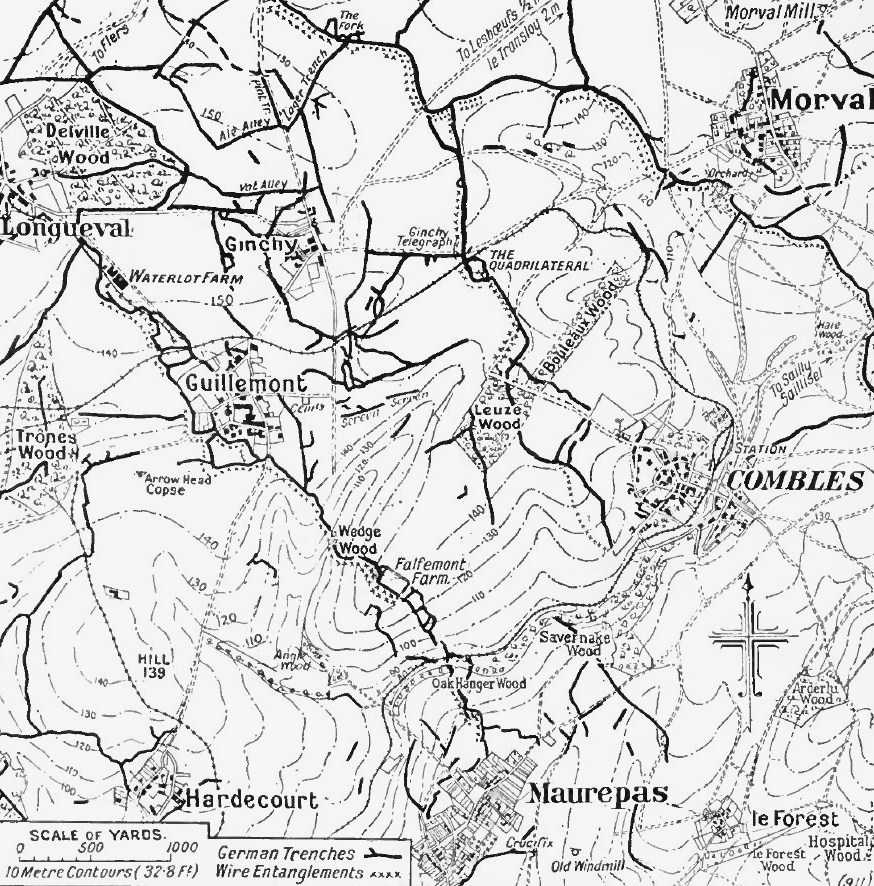
While doing so they were subjected to heavy shelling and, according to the Regimental History, equally heavy and persistent rain. In the four days before they were relieved to bivouacs behind the line, there were 34 casualties - one officer and two men killed, and 31 wounded (more were wounded but were able to remain at duty).
On 3rd September, 5th Division attacked towards Falfemont Farm. The 95th Brigade, including 1st Devons, was on the left of the divisional front. The first objective was a line of trenches south-west of Guillemont, and the second was the main line of German defences running between Guillemont and Wedge Wood. The third objective was a sunken road running northwards between Wedge Wood and Ginchy. The Devons were on the right of the Brigade front, in support.
Following an effective preliminary artillery barrage, the attack was a success. That night, the Devons held the position they had won, with two companies in the second objective position, at Wedge Wood, and two companies in the first objective position.
Although Falfemont Farm had not yet been taken, the 1st Devons were ordered the following evening to continue the attack forward to Leuze Wood. At 6.55pm, the two leading companies assaulted the wood, and "with very little opposition, took up position along line, parallel and about 50 yards inside the SW edge of the Wood, and started to consolidate". At 8.17pm, they were joined by the third company - "Patrols went out but found none of the enemy".
Again, they held the position they had gained overnight. At 3.20pm the next afternoon, the fourth company moved up to hold the line, while the first three companies took the attack further forward, against the section of the German line from Combles up to the position east of Ginchy called the Quadrilateral, which ran through the north-eastern corner of the wood.
Again, the attack was a success. The War Diary states that the attack started at 4.0pm, and that fifteen minutes later "the trench was in our hands, and consolidation was commenced". At 6.30pm, they were relieved by a battalion of the Royal Irish Fusiliers (the War Diary says the 7th, but the Official History says the 8th). By dawn the next morning, they were in bivouacs, appropriately perhaps, in Happy Valley. Falfemont Farm was taken by other units of 5th Division in the early hours of 5th September.
However, the attack was not without cost. Over the three days, the Battalion had suffered 32 men killed, and five officers and 153 men wounded. A further four men were missing. Relief, however, was not yet due to the whole division. While most divisional forces withdrew, others, including the 1st Devons, formed part of a composite brigade consisting of battalions and machine gun companies drawn from different brigades, to help hold the front secured a few days before. On 10th September, the 1st Devons were sent back to Falfemont Farm, which had now become the reserve position of the advancing British line. The War Diary does not say so, but according to other accounts, by this stage there was nothing left standing of the farm, which had been comprehensively destroyed by artillery barrage.
On 12th September, the 1st Devons were moved forward to hold the British front line position in Leuze Wood, which they had won only a few days before. This was shelled "rather heavily", according to the War Diary. Over the next two days, the casualty list increased still further - 17 men killed, and three officers and 53 men wounded, with two officers and 13 men missing. The composite brigade was relieved overnight on 13th/14th September.
The Battle of Morval
The Regimental History comments at this point:
The composite brigade had only been back at rest four days when the Fifth Division returned to the line and took over a position facing [the village of] Morval ... Fortunately for the Devons ... they remained in reserve until [24th September] and escaped with only two casualties. The battalion was in no condition to stand heavy losses. Since its return to the fighting area, drafts and discharges from hospital had not balanced a sick list of 60 officers ... its "parapet strength" was under 400.
In the meantime, the third stage of the Battle of the Somme had begun on 15th September, with the aim of capturing the original German third line defensive system (which it had been hoped might fall on 1st July). At the Battle of Flers-Courcelette, as it came to be known, "a considerable stretch of the German front line had been captured and their Second Line system had been significantly breached in the Flers sector". The new British secret weapon of the tank had been unveiled, though not with unqualified success - see the story of Cecil William Odam.
But, as Peter Hart observes:
The British casualties all long the line had been atrocious and were comparable in percentage terms with the debacle of July ... In simple terms, the army had captured about twice the number of square miles of territory, but twice not very much is still not much ... the German first line that had been taken was only the original German Third Line. Since early July, new lines, redoubts and switches had been dug to replace those the Allies had so painstakingly captured ... there was no imminent prospect of a breakthrough and the German defensive system retained its amazing resilience.
The fighting on the Somme was far from over. The next stage of the offensive was scheduled for 25th September, and was designed to achieve what had not been managed on 15th September. There was an extremely heavy preliminary artillery bombardment, while the tactics for the attack involved a continuous creeping barrage, with no gaps for tanks - instead, the tanks were to follow the advancing infantry and be directed towards any German strongpoints holding up the advance. On the right of the British front, four divisions, including 5th Division, were concentrated within a narrow front, so as to maximise the force of the attack. The French also attacked on the right of the British, in the southern part of the front.
The 5th Division was planned to attack the village of Morval. The 95th Brigade was on the right of the Division, with the Devons on the left of the Brigade front. This time, the tactics for the attack worked. At 12.35pm, the attack began. The two leading companies attacked the first objective, a trench to the west of Morval called (by the British) "Bovril Trench", and on encountering resistance, were immediately reinforced by the other two companies. Bovril Trench was taken by 12.57pm, twenty-two minutes later.
The two leading companies then attacked the second objective, a sunken road running roughly parallel with Bovril Trench. This too was successfully captured by 1.45pm, many prisoners being taken.
The attack then advanced up "Mince Trench" which ran up the hill towards the south of Morval, at right angles to the sunken road. At the top of the hill, the Devons "could get no further. They at once made some strong points and consolidated the position". However, their neighbours in 15th Brigade, on the left of 5th Division's front, had managed to take the village, successfully clearing all the dugouts and cellars. A line was established to the east of the village and connected with the position gained by the 1st Devons to the south. On the evening of 26th September, the Battalion was relieved and went into bivouacs.
The 1st Devons thus made a significant contribution to success at Morval (which itself was a significant contribution to success all along the German front line system on 25th September).
But the success had come at a price. For 25th September, the War Diary recorded:
On 26th September, as the Battalion left the battlefield, a further thirteen other ranks were wounded. Together with the other casualties sustained since the Battalion had returned to the Somme, the total represented nearly 40% of those in action. Other units in 5th Division were in similar circumstances.
Death
As was often the case after a major battle, some uncertainty evidently surrounded what had happened those who had fought in it, including George. On 27th October 1916, a casualty list was issued which included (though it did not say so explicitly) the names of those in the 1st Devons who had been killed or wounded during the battle for Morval. "G Peters (Dartmouth)" was listed amongst the wounded (Western Morning News 28th October 1916 and Western Times 30th October 1916).
Just under a month later, on 25th November 1916, the Western Times included him in another casualty list as "previously reported wounded, now reported wounded and missing". On this occasion he was described as of Churston Ferrers, rather than of Dartmouth, presumably because this was where his wife Kate, his next of kin, was living.
Finally, on 30th November 1916, the Western Times reported, in a list of local casualties, "Pte G Peters (Churston Ferrers) killed".
The Soldiers Effects Register, and all subsequent records, including those of the Commonwealth War Graves Commission, give George's date of death as 26th September 1916, and state that he was killed in action. This date was also recorded after the war on the St Petrox Memorial in Dartmouth. We have therefore commemorated him on the centenary of that date, and recorded him as "killed in action".
Commemoration
George is one of more than 72,000 men commemorated on the Thiepval Memorial, the Memorial to the Missing on the Somme, for those dying in the Somme sector before 20th March 1918 and who have no known grave.
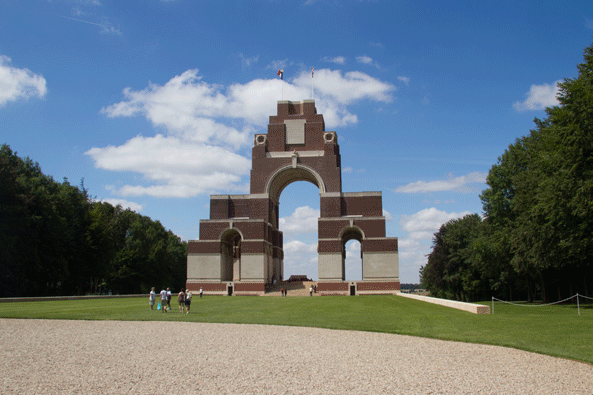

In Dartmouth, he is commemorated with his brother Percy on the Dartmouth Town Memorial, the St Saviour's Memorial Board, and the St Petrox Memorial Board.
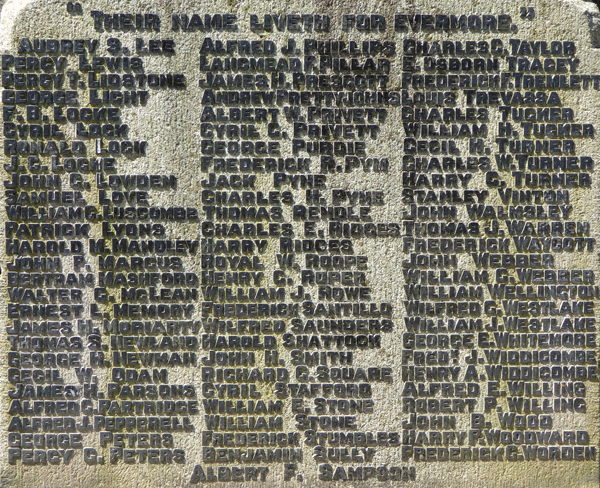
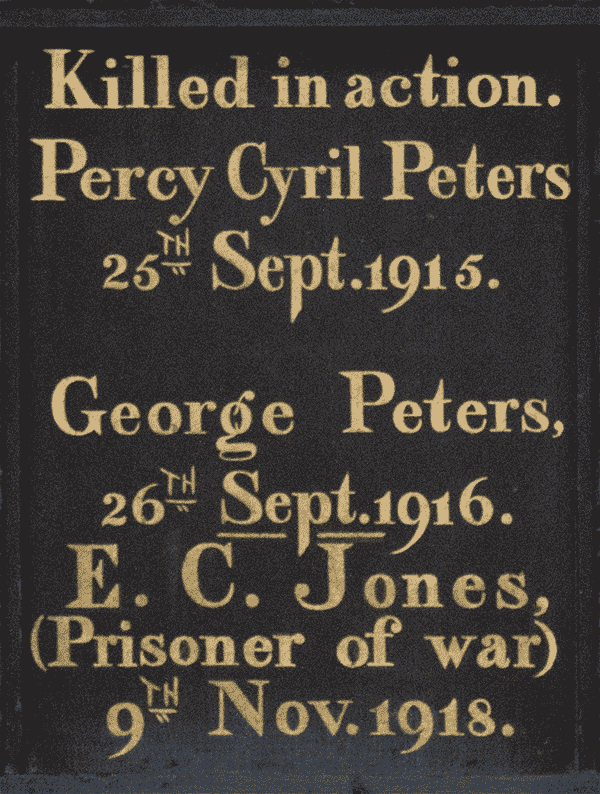
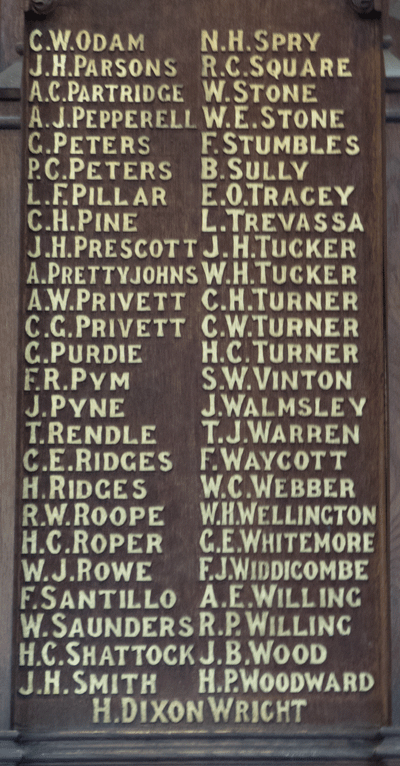
After the war, Kate, George's widow, married his elder brother Cecil Maurice. Cecil had volunteered in August 1915 for the "Devon Labourers, attached to the Royal Engineers", according to the Dartmouth Chronicle. His service papers have survived; his medical examination took place in Dartmouth on 19th August 1915 and he attested for the Royal Engineers in London the following day. He embarked for France eight days later as part of the 5th Labour Battalion RE, subsequently being incorporated into the Labour Corps when it was formed in 1917. He was demobilised in March 1919.
Sources
War Diary of 1st Battalion Devonshire Regiment January 1916-November 1917 available from the National Archives, fee payable for download, reference WO 95/1579/3
The Devonshire Regiment 1914-1918, compiled by C T Atkinson, publ 1926, Exeter and London
The Somme, by Peter Hart, publ 2006, Cassell, London
Somme 1916, A Battlefield Companion, publ 2016, The History Press
Information Held on Database
| Surname: | Peters |
| Forenames: | George |
| Rank: | Private |
| Service Number: | 11279 |
| Military Unit: | 1st Bn Devonshire Regiment |
| Date of Death: | 26 Sep 1916 |
| Age at Death: | 25 |
| Cause of Death: | Killed in action |
| Action Resulting in Death: | Battle of the Somme |
| Place of Death: | Near Morval, France |
| Place of Burial: | Commemorated Thiepval Memorial, France |
| Born or Lived in Dartmouth? | Yes |
| On Dartmouth War Memorial? | Yes |
| On St Saviour's Memorials? | Yes |
| On St Petrox Memorials? | Yes |
| On Flavel Church Memorials? | No |
| In Longcross Cemetery? | No |
| In St Clement's Churchyard? | No |
| On a Private Memorial? | No |
| On Another Memorial? | No |















